Numerous myths and stories from around the world have snakes and snakes in important roles. Sometimes these legendary creatures take the form of ordinary snakes. Other times, they assume forms that are either magical or gruesome. For a long time, the serpent gods have been associated with both good and evil. They have come to stand for life and death, as well as creation and destruction.
The Norse serpent god Jormungandr
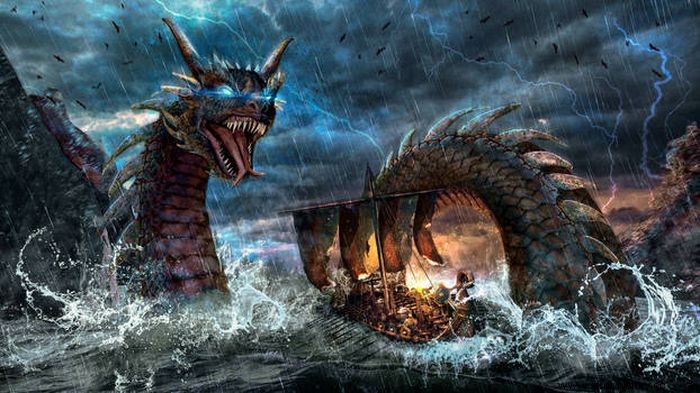
In Norse mythology, Loki's secret marriage to the giantess Angrboa produced Hel, Fenris and Jormugandr. Loki hid their offspring for as long as possible, but they grew so fast that they could not stay hidden in the cave where they were born.
Odin dreaded Loki's offspring while sitting on Hlidskialf's supernatural throne. However, Odin wanted to eliminate dangers, so he gave Hel control of Helheim and all the dead (scared the chosen ones killed) and threw Jormugandr into the sea. There the snake swelled up to the called Midgard like an Ouroboros eating its tail.
Tors Midgardsslangehistorie
One day Tor and Tyr went to see Hymir. When the host saw Thor eating two large oxen for supper, he decided to fish the next day. Thor decided to help his host, but he had to pick up his bait. Then, the god of thunder killed the host's most excellent bull, Himinbrioter ("the breaker"). Then he cut off the bull's head and began to row.
As they went on to the sea, the giant Thor warned that they had passed the usual fishing spot, but the god did not listen. Instead, Hymir warned them that they could be in danger if they met the Midgard Serpent. Thor ignored him and kept rowing until he thought they were over the giant snake.
Thor sifted Jormugandr with the cow's head as bait. While the thunder god was fishing, the giant caught two whales for breakfast. Thor then rejected the host's request to return, waiting for Jormugandr to bite. He did not like it, but he had to adjust. When Thor felt a jerk, he pulled as hard as he could.
A colossal storm broke out of nowhere, and Thor knew he had the Midgard Serpent in his resistance. Thor's stiffened feet went through the boat as he tried to pull Jormugandr from the sea, and the Midgard serpent's head eventually appeared. Thor pulled out the hammer to kill the snake, but the giant broke the fishing line to save the boat.
Jormugandr sank when Thor hit Hymir with the hammer for losing his prey. The battle threw the giant overboard, so he swam ashore and waited for Thor to bring the boat with the whales to the beach. But instead they took the whales and the boat and ate at home.
Mesopotamian serpent gods and goddesses
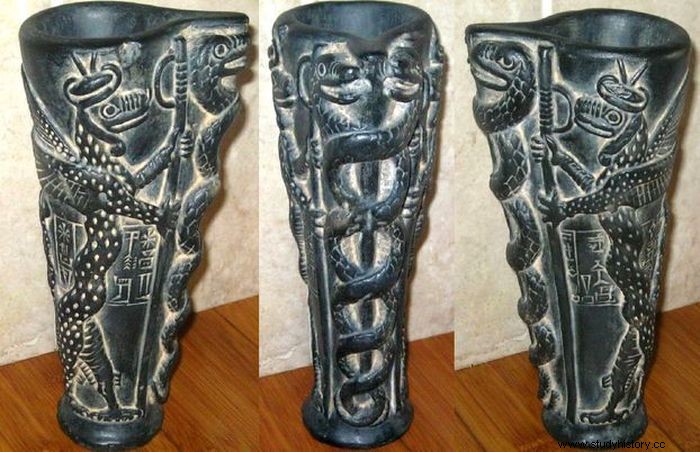
Ningishzida
This Sumerian god is a fascinating person. People thought he had something to do with agriculture and the underworld. However, his symbol is a convoluted snake, which looks like the roots of a tree. This depiction would fit in with his overall theme since his name means "Lord of the good tree" in English.
An image of the large snake Basmu wrapped around a branch is another sign associated with Ningishzida. As you might expect, this is very similar to Hermes' Caduceus, but there is no connection between the two.
Basmu, on the other hand, is said to be a massive snake with wings and hind legs. Their name roughly means "Venomous Snake", and they appear to represent rebirth, death and dying. This godly creature became a symbol of fertility goddesses and birth in Mesopotamia. With this in mind, Basmu is a sign of Ningishzida when it looks like a snake wrapped around a rod or two snakes that are connected. Few scientists also wonder if the tree in Ningishzida's name could mean a vine since the god is also closely associated with alcohol.
Mushussu
With a name that can be translated to "Furious Snake", you can bet that this snake spirit was not afraid to take on the world. Mushussu is a strange creature seen at the Ishtar Gate in Babylon, now in Hillah, Iraq. They have a long neck, a horn and a tongue with two forks, and their bodies are thin and look like dogs.
Mushussu was seen as a guardian spirit more than anything else. It was very close to Marduk, the main deity in Babylonia after Marduk defeated it in battle.
Egyptian serpent gods and goddesses

In Egyptian mythology, snakes have many meanings and interpretations, as shown by the Serpent gods. Snakes are both guards and harmful because of their deadly bites. Ancient Egyptian serpent gods include their highs and lows.
wadjet
She is the Egyptian cobra goddess of birth and child. Wadjet was subsequently associated with pharaoh protection. She has a constantly flared hood as if she is ready to attack. This interpretation of Wadjet can be linked to her duty as Pharaoh's department or Pharaoh's obligation to protect and administer the kingdom.
Other images of the goddess show her wearing the red crown (also called deshret) in Lower Egypt, the Nile Delta region, making her one of its patron deities. Wadjets deshret suggests that she cares about the country's sovereign. Wadjet is one of the goddesses in Eye of Ra, along with Hathor, Sekhmet, Bastet, Raet and Mut. The depiction of the eye is like a snake with a deshret.
Nehebkau
Nehebkau is a prehistoric Egyptian deity and son of the Renenut. After the creation of the world, this serpent god was associated with the Egyptian sun god Ra. He is eternal, as snakes are a symbol of eternity. Nehebkau is considered the protector of the underworld and a court of the Ma'at deity.
Forty-two lesser gods helped Osiris judge with The Weighing of the Heart. The chapter on the book of the dead shows these gods and their territories. Nehebkau, a burial snake deity, succeeded Ra as king of heaven.
Renenutet
The appearance of the reindeer nut is more shaky than the Wadjets. Egyptian deity has several appearances; Some images show her as a lion-headed lady, while others show her as a snake or cobra-headed woman. In addition, she would wear a double-breasted headdress or a solar panel.
The appearance of the reindeer nut deceives:In the underworld she is a huge fire-breathing snake. The reindeer nut could stop men's hearts with a single glance. She is also the mother of Nehebkau, the giant snake that guards the underworld. The reindeer nut would also give babies hidden names to protect them from curses. The reindeer nut sounds like a mother figure, "She Who Rears" is an appropriate epithet.
Apep
Apep is the "lord of chaos" or "god of death", one of the early Egyptian gods; his representation is like a giant, evil serpent. In other versions he is a crocodile. Both depictions of Apep as a reptile are translated in the same way, and crocodiles were like snakes. Both were powerful symbols of rebirth.
Ancient Egyptians believed that Apep existed before the earth was created and was a monster of chaos. Ra would fight Apep every night to maintain cosmic equilibrium, but Apep would always rise again.
Meretseger
Meretseger, a goddess of mercy and punishment, looked over the dead and punished the grave thieves. Those who harmed her or disrespected Necropolis were blinded and bitten by snakes. You would think troublemakers would learn from a deity whose name means "She who loves silence." Meretseger guarded Theban Necropolis. In ancient Egypt, she was a local snake goddess. Egypt's serpent worship flourished throughout the New Kingdom (1550-1070 BCE).
The five serpent gods and goddesses of Hinduism
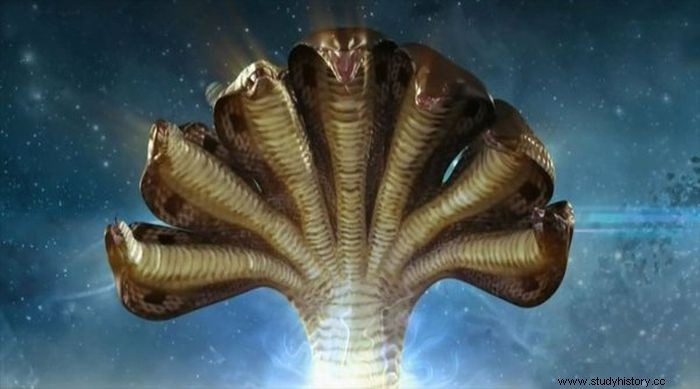
Nagas are half human, half snake celestial entities in Hindu mythology. In Hinduism, they are loved as charitable deities while at the same time being fearsome opponents. Nagas is related to water and the protection of riches.
Adishesha
Adishesha is the eldest brother of Takshaka, Vasuki and over 100 snakes. He is often with Lord Vishnu; the two have even been reborn as brothers. Adishesha will reportedly remain unchanged at the end of time. Shesha is immortal. It is believed that the planets are under the armor of Naga.
Manasa
People worshiped this goddess who looked like a serpent and was known for bringing fertility and wealth. Manasa's pictures show her reclining on a lotus with a child in her lap. As Vasuki's sister, she is related to Adishesha, Takshaka and her son Astika.
Astika
Astika is the son of the sage Jaratkaru and the serpent goddess Manasa Devi. Astika allegedly stopped a snake victim to avenge the snakebite death of Kuru King Janamejaya's father. Kuru was an Indian tribal alliance from the Iron Age (1200–900 BC). Delhi, Haryana and Punjab make up Kuru. Astika rescued Takshaka, a monarch of Nagas and Indra's friend, and asked the king to stop snake persecution. Modern Hinduism, Buddhism and Jainism remember Naga Panchami.
Kaliya
Naga is no ordinary snake. Like a 100-head serpentine drag. Kaliya lived in a poisonous river that humans and birds avoided. Kaliya feared Garuda, Lord Vishnu's golden-winged vahana, who hated snakes. Lord Krishna fought the snake as he retrieved a ball from the river. Krishna was triumphant and danced over Kaliya's hoods while playing the flute.
Vasuki
Another Naga king is Shiva's friend. Shiva loved Vasuki so much that he wore it like a necklace. Vasuki's nagamani gem is another important feature. This jewel shows his superior rank as a serpent deity. In Africa, Asia and South America, snake bites are treated with nagamani (the cobra pearl). Nagamani is a sparkling green or black stone.
Snake gods and goddesses from Greece
Hydraen
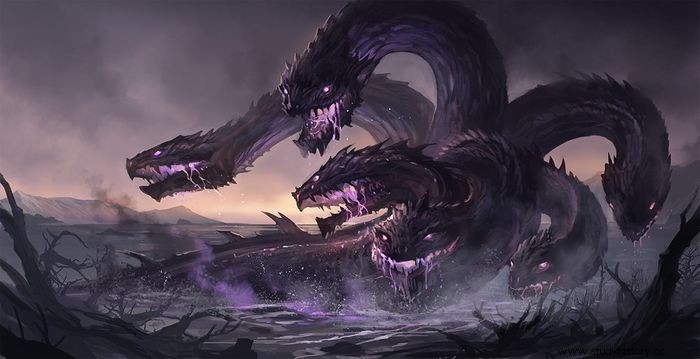
Heracles, a famous Greek hero, made this monster look like a piece of cake. Hera made the hydra to kill Heracles during one of his twelve works for King Eurystheus, and people thought it was a huge sea serpent with nine heads.
One of the most famous ancient Greek myths is the story of Heracles' twelve works. As his father's legal wife, Hera caused this sad hero to commit suicide by murdering his wife and their children. To sum up, the problem with the hydra was that the breath was the worst ever, and as if its nine heads were not enough, when Heracles once chopped, two more sprouted instead. So it is possible that being immortal has something to do with the unusual behavior of the huge sea serpent.
Hercules was lucky to have his nephew Iolaus help him. Iolaus used a mark to cut the stump of the hydra so that it could not grow more heads. Besides, Athena was definitely on the side of her half-brother in this family battle. With Athena's golden sword, which she gave to Heracles during an earlier battle, Heracles could damage the hydra enough to kill it in the same way.
Asklepios
Asclepius started in the Homer Iliad as an ordinary guy, but he became a god in ancient Greece because he was good at medicine. Even though he was just a doctor, most people thought he was a god because he was the son of Apollo and a human princess. And it was awful to Asklepios that Zeus did not like doctors, especially gods who were doctors. So Zeus killed Asklepios because he feared he would make people live forever. Apollo reached the finish line by killing the Cyclops who made the thunderbolt that killed his son.
The most famous thing about Asclepius was neither that he was a father nor that he died prematurely. Instead, it was his medicine stick. It was just a small branch with a snake wrapped around it. The Asclepius rod was much more straightforward than Hermes' Caduceus, a rod with two snakes wrapped around it and a pair of wings. In modern medicine, however, the Caduceus and Asclepius rod are used in the same way.
In Greek mythology, snakes are messengers from the gods and symbols of life and death. Snakes were also often seen as a sign of immortality. We're talking more about this when we talk about the scary Gorgons and the giant Hydra.
gorgonene
These three evil monster women are Stheno, Euryale and Medusa. The ancient Greeks feared gorgons because they were ugly and dangerous. They were said to have copper hands and gold wings.
Although the history of Medusa is known and debated, everyone knows that she is the only one of the Gorgons who is not immortal because she was born as a human being. But unlike her sisters, whose heads are full of snakes, which may be a sign that they will live forever, some believe that Medusa's change from a beautiful mortal to a cruel serpent animal shows that snakes can return to life. After all that had happened to her, one could only hope that Medusa's snakes would give her another chance.
Korean Serpent God - Eopsin
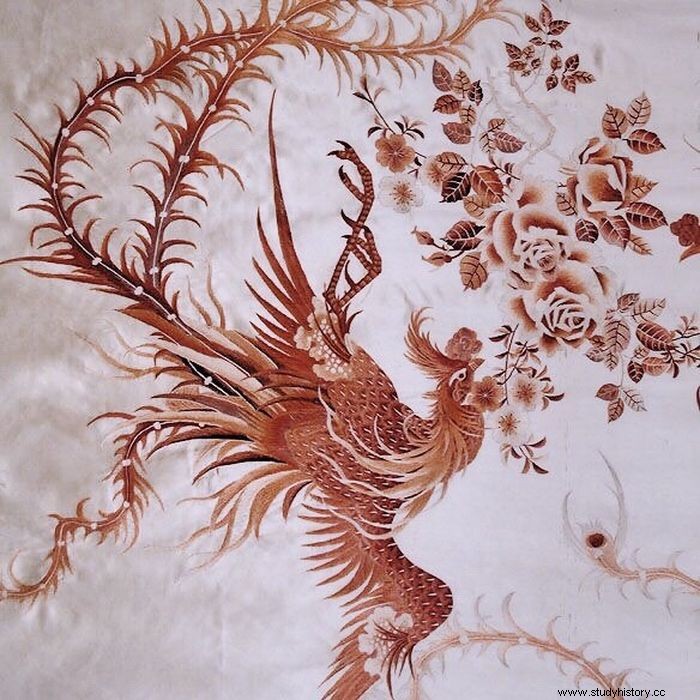
In Korean folklore, Eopsin is the god of wealth and storage. In mythology, she is many different things besides a snake, like a toad or a wesel. Eopsin has also taken human form, but this rarely happens and only in certain situations.
Most of the time, the snake goddess lives on the rooftops. It is a bad sign if Eopsin is found elsewhere in the house. This means that the house's physical and social stability deteriorates, and she no longer has reason to stay. Even though the guardian is seen as independent and is known for doing her own thing, people still try to make her happy by giving her gifts.
Chilseong Bonpuli says that Eopsin is the mother of seven other Korean goddesses. She is also the guardian of the home and worldly goods. She is said to be a black snake with human ears in its snake shape, so if you find this snake hidden in your attic, you should leave it alone.
Quetzalcoatl was the Aztec spring serpent god
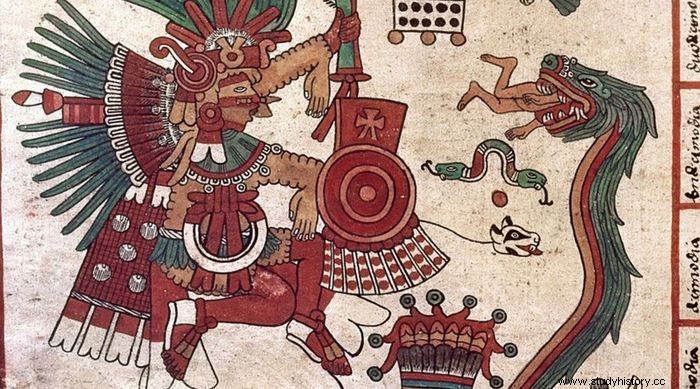
Quetzalcoatl is an Aztec myth about a feathered serpent believed to have created humans and to be the god who separates the land from the sky. The oldest records show that this serpent god was close to Tlaloc, the god of rain and water, and that his original domain was plants.
During the Aztecs (1100-1521 AD), the worship of Quetzalcoatl took place as the god of the priests. He was the link between gods and humans and the protector of many craftsmen. Also, like other serpent gods, this feathered serpent was seen as the personification of life, death and rebirth.
Celtic Serpent Goddess - Corra
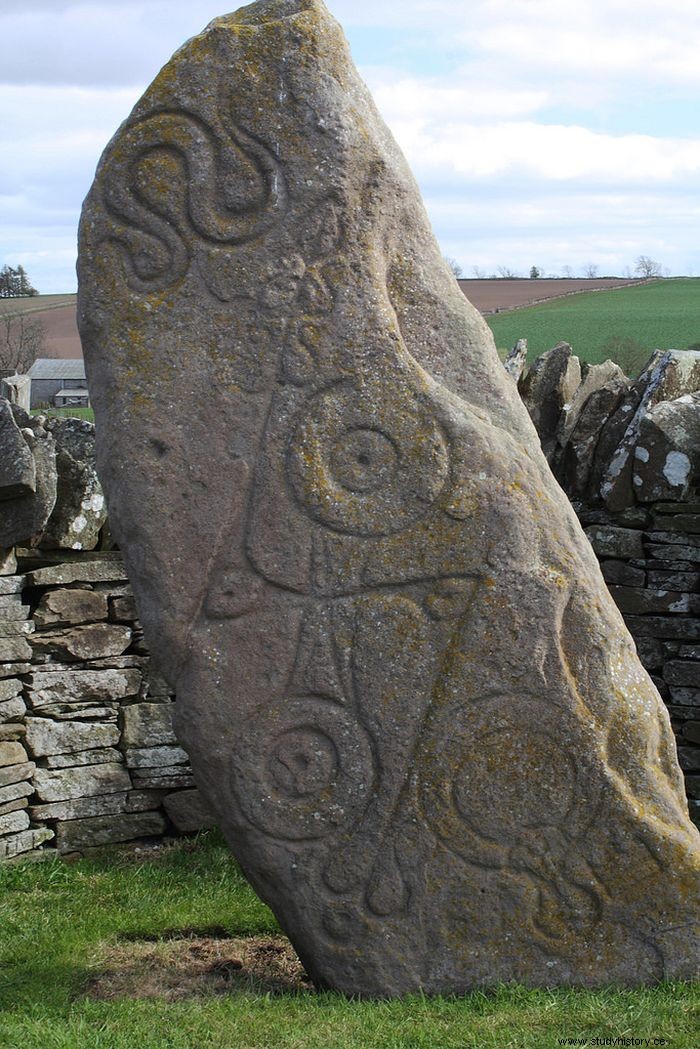
Corra, a Celtic goddess, represents life, death, fertility and the earth. Two intertwined snakes symbolize this serpent goddess, and her themes include rebirth and spiritual change. One of her stories remains about her passing. Ireland has never had snakes. No. Saint Patrick "drove the serpents" from Ireland. Many experts believe that Saint Patrick did not eliminate the beast, but this story shows how Christianity suppressed Celtic and Druidic faith.
The lack of snakes in Ireland, which is Corra's most important manifestation, suggests that Christianity supplanted ancient religion and devotion to the goddess. However, Corra did not disappear. Saint Patrick confronted the Celtic goddess of Lough Derg after chasing her across Ireland. After two days of being swallowed, he cut himself out and turned her to stone. Her death and metamorphosis mean the end of her life cycle.
The Rainbow Snake is Australia's creative snake god
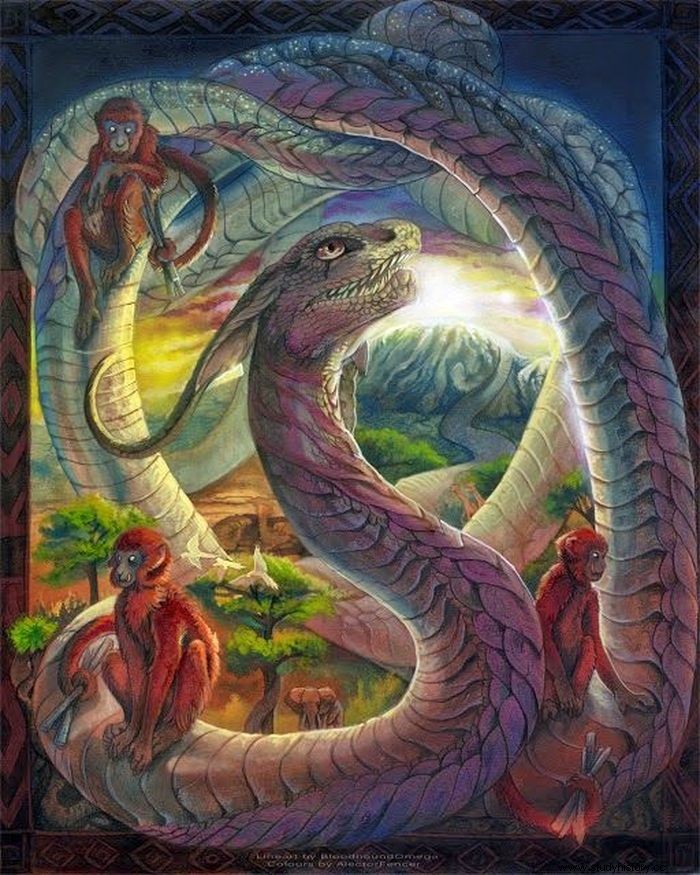
In indigenous Australian mythology, the rainbow snake is the most important creator god. In addition, they are revered in some cultures as the deity of the weather. That's because their image in ancient art looks like a rainbow.
It is important to note that "Rainbow Serpent" is a catch term that anthropologists came up with when they heard similar stories from all over Australia about a giant snake that created life. People and nations have different creation stories, and each has its name for the snake that gives life. But no matter what story you tell, it is clear that water was the source of life that the rainbow snake provided. Some cultures also said that this serpent created the universe. Others saw them as either male or female or none of them.
According to history, the rainbow snake slept underground for thousands of years until it woke up one day. As the giant snake moved, the land on earth began to take shape. Other animals woke up where they were going. People believed that the snake lived in bodies of water, which made it a symbol of both water and changing seasons.
The conclusion
There are stories about mysterious snakes from both the past and the present. People have said for hundreds of years that they have seen giant snakes or monsters that look like snakes in the ocean or lakes. Many marine scientists agree that there may be creatures in the depths that we do not know about yet, but no one has found evidence of a completely new type of sea worm. Most of the time, weird things are seen swimming on the surface of the water just masses of seaweed, floating logs, lines of porpoises jumping into the air, giant squid or common sharks or sea lions.
